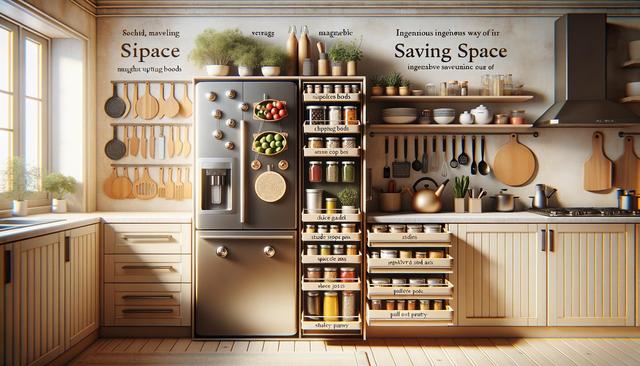Amazing Space Saving Kitchen Hacks
Maximize your kitchen’s potential with innovative space-saving hacks. Utilize vertical storage, multi-functional furniture, and smart organization solutions to create a clutter-free and efficient space, perfect for cooking and entertaining in limited kitchen areas.

Vertical Storage: Going Up Instead of Out
When horizontal space is limited, vertical storage becomes your best ally in the kitchen. Using your wall space efficiently can transform your kitchen from cluttered to organized without the need for major renovations. Consider installing open shelves above your countertops or along empty walls to store dishes, glassware, or dry goods. Magnetic strips can be mounted to hold knives or spice jars, freeing up drawer space. Pegboards are another highly adaptable solution, allowing you to hang frequently used utensils, pans, or even small baskets for added versatility.
Some useful vertical storage ideas include:
- Wall-mounted racks for pots and pans
- Over-the-door organizers for pantry or cabinet doors
- Tiered hanging baskets for fruits, vegetables, or kitchen linens
By utilizing your walls, you not only keep your countertops clear but also bring a sense of openness to the room. Vertical storage also makes items more visible and accessible, which is especially helpful when cooking in small spaces.
Smart Cabinet Solutions
Cabinets are often underutilized, especially when it comes to the vertical space within them. Adding shelf risers, pull-out drawers, and corner solutions can significantly increase the usability of your cabinets without needing a full remodel. Shelf risers double your storage capacity by allowing you to stack items more efficiently, while pull-out drawers let you access items at the back of the cabinet with ease.
Here are a few cabinet hacks to consider:
- Lazy Susans in corner cabinets for easy access
- Pull-out spice racks or narrow slide-out drawers near the stove
- Stackable bins or baskets for grouping similar items
These tools not only maximize space but also promote better organization and faster meal prep. Investing in customizable cabinet inserts can make a notable difference in how you use each inch of available space.
Multi-Functional Furniture for Small Kitchens
If your kitchen doubles as a dining area or workspace, multi-functional furniture can be a practical solution. Compact tables that fold down or expand when needed, rolling kitchen islands, and benches with built-in storage are great ways to combine utility with style. These pieces adapt to your needs while keeping the space open and functional.
Popular examples of space-efficient furniture include:
- Drop-leaf tables that can be extended for guests
- Rolling carts that serve as additional prep areas and can be stored away
- Storage benches that offer both seating and hidden compartments
Choosing furniture with multiple functions helps reduce the number of individual items needed in your kitchen, giving you more room to move and work comfortably.
Drawer and Countertop Organization
Cluttered drawers and countertops can make even the largest kitchens feel cramped. Drawer dividers, utensil trays, and stackable containers are essential for maintaining order. In drawers, use organizers to separate different types of tools and gadgets, making everything easy to find when you need it. On countertops, limit the number of items kept out and use storage solutions that serve dual purposes, such as utensil holders that double as decor.
Effective countertop and drawer strategies include:
- Keeping only daily-use items on the countertop
- Using clear containers for dry goods
- Labeling jars and containers for quick identification
By keeping surfaces clean and drawers sorted, you create a more efficient workspace that reduces stress and improves functionality in the kitchen.
Creative Use of Unused Spaces
Sometimes the key to saving space lies in noticing what you’re not using. Areas like the sides of cabinets, the tops of appliances, and even the space above the fridge can be transformed into valuable storage zones. Slim rolling shelves can fit between appliances, while hooks and rails can be added to the sides of cabinets for towels or tools. Even the underside of shelves can be used with clip-on baskets or mug hooks.
Look for these overlooked areas:
- Above-cabinet space for baskets or bins
- Cabinet sides for hanging rails or magnetic strips
- Toe-kick drawers at the bottom of base cabinets
Using these less obvious areas not only helps in storing more but also contributes to maintaining a tidy, well-organized kitchen. With a bit of creativity, even the most compact kitchens can feel more spacious and efficient.
Conclusion
Small kitchens don’t have to mean small potential. By embracing smart, space-saving strategies like vertical storage, clever cabinet enhancements, and multifunctional furniture, it’s possible to create a kitchen that is both practical and pleasant to use. These thoughtful hacks are especially helpful for apartment dwellers, families in cozy homes, or anyone looking to streamline their cooking space without sacrificing style or function. With a little planning and creativity, your kitchen can become a model of efficiency and comfort.